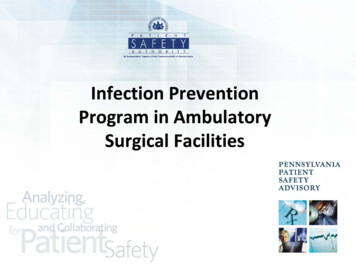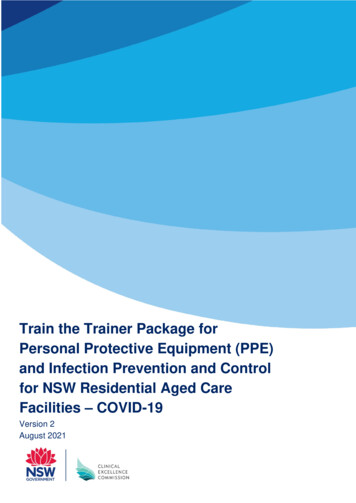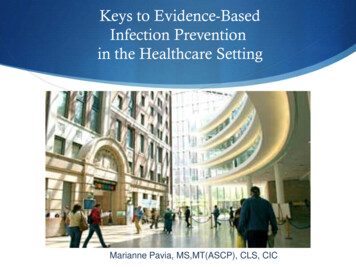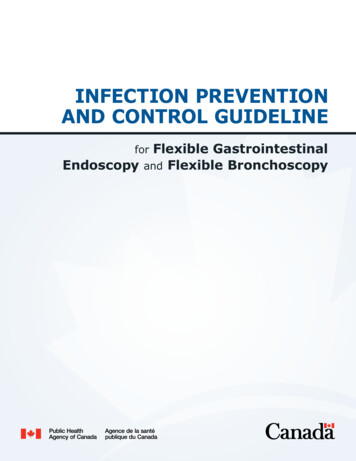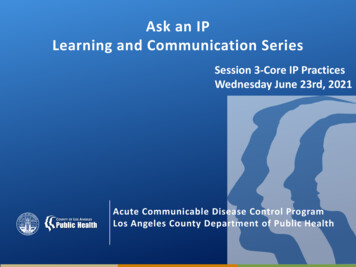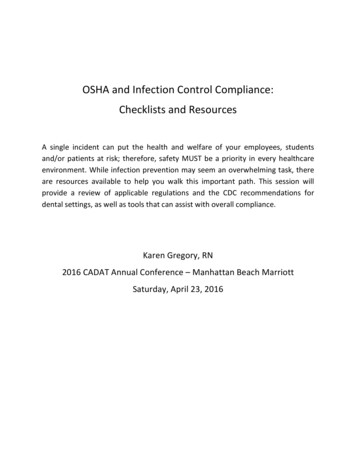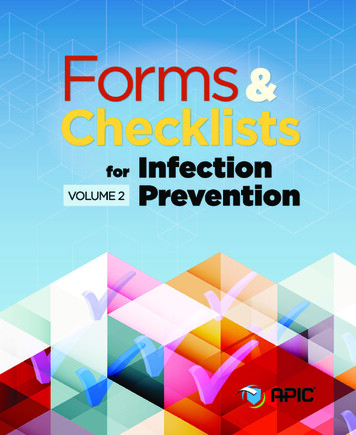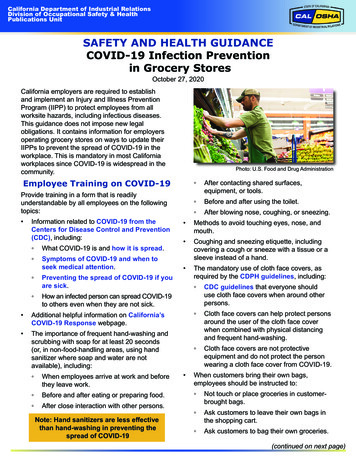
Transcription
California Department of Industrial RelationsDivision of Occupational Safety & HealthPublications UnitSAFETY AND HEALTH GUIDANCECOVID-19 Infection Preventionin Grocery StoresOctober 27, 2020California employers are required to establishand implement an Injury and Illness PreventionProgram (IIPP) to protect employees from allworksite hazards, including infectious diseases.This guidance does not impose new legalobligations. It contains information for employersoperating grocery stores on ways to update theirIIPPs to prevent the spread of COVID-19 in theworkplace. This is mandatory in most Californiaworkplaces since COVID-19 is widespread in thecommunity.Photo: U.S. Food and Drug AdministrationEmployee Training on COVID-19Provide training in a form that is readilyunderstandable by all employees on the followingtopics: Information related to COVID-19 from theCenters for Disease Control and Prevention(CDC), including: What COVID-19 is and how it is spread. Symptoms of COVID-19 and when toseek medical attention. After contacting shared surfaces,equipment, or tools. Before and after using the toilet. After blowing nose, coughing, or sneezing. Methods to avoid touching eyes, nose, andmouth. Coughing and sneezing etiquette, includingcovering a cough or sneeze with a tissue or asleeve instead of a hand. The mandatory use of cloth face covers, asrequired by the CDPH guidelines, including:Preventing the spread of COVID-19 if youare sick. CDC guidelines that everyone shoulduse cloth face covers when around otherpersons. Cloth face covers can help protect personsaround the user of the cloth face coverwhen combined with physical distancingand frequent hand-washing. Cloth face covers are not protectiveequipment and do not protect the personwearing a cloth face cover from COVID-19.How an infected person can spread COVID-19to others even when they are not sick. Additional helpful information on California’sCOVID-19 Response webpage. The importance of frequent hand-washing andscrubbing with soap for at least 20 seconds(or, in non-food-handling areas, using handsanitizer where soap and water are notavailable), including: When employees arrive at work and beforethey leave work. Before and after eating or preparing food. After close interaction with other persons.Note: Hand sanitizers are less effectivethan hand-washing in preventing thespread of COVID-19 When customers bring their own bags,employees should be instructed to: Not touch or place groceries in customerbrought bags. Ask customers to leave their own bags inthe shopping cart. Ask customers to bag their own groceries.(continued on next page)
Not touching or handling containers orrecycling returned for reuse or redemptionwithout personal protective equipment (PPE).Employees must be trained to wear andremove PPE safely without self-contamination.Safe use of cleaners and disinfectants, whichincludes: The hazards of the cleaners anddisinfectants used at the worksite. Ventilation requirements. Wearing PPE (such as disposable gloves). Ensuring cleaners and disinfectants areused in a manner safe for employees.Maintaining more than six feet of separationfrom others as much as possible and limitingclose contact (see physical distancinginformation below).The importance of not coming to work if theyhave symptoms of COVID-19 as describedby the CDC, such as a fever or chills, cough,shortness of breath or difficulty breathing,fatigue, muscle or body aches, headache, newloss of taste or smell, sore throat, congestionor runny nose, nausea, vomiting, or diarrheaor if they live with or have had close contactwith someone who has been diagnosed withCOVID-19. To seek medical attention if the symptomsbecome severe including persistent pain orpressure in the chest, confusion, or bluishlips or face. Updates and further details areavailable on CDC’s webpage. Information on employer or governmentsponsored leave benefits the employeemay be entitled to receive that would makeit financially easier to stay at home. Seeadditional information on governmentprograms supporting sick leave andworkers’ compensation for COVID-19,including employees’ sick leave rights underthe Families First Coronavirus ResponseAct and the Governor’s Executive OrderN-51-20, and employees’ rights to workers’compensation benefits and presumption of theworkrelatedness of COVID-19 pursuant to theGovernor’s Executive Order N-62-20 whilethat Order is in effect. Some cities and countiesalso require employers to provide sick leavebenefits to employees.Increase Cleaning andDisinfectionEstablish and implement procedures to routinelyclean and disinfect commonly touched surfaces andobjects (e.g., keypads; cash registers; scanners;shared utensils, equipment, or surfaces in foodhandling or prepping areas; equipment controls;carts) throughout the workday, including: Using products that are EPA-approved for useagainst the virus that causes COVID-19 andare also safe for food establishments. Providing EPA-registered disposable wipesfor employees to wipe down commonly usedsurfaces before use and for employees andcustomers to wipe down shopping carts andbaskets. Following the manufacturer’s instructions forall cleaning and disinfection products (e.g.,safety requirements, protective equipment,concentration, contact time). Ensuring there are adequate supplies tosupport cleaning and disinfection practices,including cleaning products and gloves. Creating procedures to close access and deepclean, preferably with a professional cleaningservice, an area where a person confirmed orpresumed to have COVID-19 has been. Anyperson cleaning the area should be equippedwith proper PPE for COVID-19 disinfection(disposable gown, gloves, eye protection, andmask or respirator) in addition to PPE requiredfor cleaning products. Requiring frequent cleaning and disinfection ofcollection points and areas where recyclableand reusable containers are processed. Use available methods to handle thesematerials remotely. Employees should not handle or processthese materials by hand without appropriatePPE (impermeable disposable gloves andcoveralls, eye protection, and a mask that isprotective against splashing liquids). Employees must be trained on the safe useand removal of PPE.(continued on next page)
Procedures to IncreasePhysical Distancing Encourage customer use of payment cardsand contactless payment. Clean frequentlyto prevent transmission between customersand provide hand sanitizer.Physical distancing is an infection control measurethat can reduce the spread of an infectious diseaseby keeping people at least six feet apart andlimiting physical contact between people. Use thefollowing physical distancing measures to stop orslow down the spread of COVID-19: Stagger break and lunch times, and spread outbreakroom chairs. Limit crew size by staggering or increasing thenumber of work shifts. Only use every other checkout register. Mark the floor so customers stay at least 6 feetapart in checkout or other lines. Self-checkout may make physicaldistancing a challenge because of thefrequent need for customer assistance.If used, make sure there are protocols toallow for physical distancing when providingcustomer assistance. Clean frequently toprevent transmission between customersand provide hand sanitizer. If customers bring their own bags, ensure: Bags are not placed on conveyor belts orany other area outside of shopping carts. Bags make no contact with employees.Limit the number of employees gathered at thestart of day or in trainings or meetings to allowemployees to spread out. Perform job interviews and orientations overthe phone or using video conferencing. Post signs at all entrances with infection controlinformation to customers, including: Customers bag their own groceries. Customers do not bag groceries in thecheckout area if they cannot maintainphysical distancing. Groceries can beplaced in a cart and bagged elsewhereby the customer. Increase the frequency of disinfection inbagging areas used by customers. To use cloth face covers in the facility asrequired by the CDPH. If a delivery driver requires a signature,have the store employee use their own penor wear gloves. To only touch products they intend topurchase. Encourage customer use of online orderand pickup. Place groceries directly into thecustomer’s trunk instead of handing themto the customer, or permit customer to loadthem. To use hand sanitizer when entering thefacility and prior to checkout. To leave their own bags in the shoppingcart and bag their own groceries so thatemployees do not contact the bags. Limit direct contact with the public andcustomers. Limit the number of customers in the storeat one time. Protect cashiers, pharmacy workers, andother workers who normally have regular,close interaction with the public withengineering controls such as Plexiglasscreens or other physical barriers, or spatialbarriers of at least six feet. Use handheld scanners to minimizehandling of purchased products. Discontinue providing samples tocustomers. Encourage employees to avoid largegatherings and practice physical distancingduring non-work hours.Good Hygiene PracticesGrocery employers must ensure bathrooms andhand-washing facilities are readily accessible to allemployees at all times. Allow extra time for employees to wash theirhands, including providing additional breaksfor hand-washing. For cashiers and baggers,hand-washing every 30 minutes is a good ruleof thumb.(continued on next page)
If employees have limited access to handwashing, employees can use disposable glovesto prevent contact with potentially contaminatedsurfaces. Encourage employees to changegloves frequently and remove them beforetouching their face, smoking, eating, or usingthe restroom. Provide an adequate supply ofgloves and make them readily available. Provide hand sanitizer at every checkoutregister and throughout the store.What to do if Workers Might beSick with COVID-19Employers can encourage sick workers to stayhome by implementing work policies that do notpenalize workers for missing work because theyhave been diagnosed with or suspect they mayhave COVID-19. Such policies may include paidtime off, increased sick leave, suspending “no-fault”absentee policies, and job protection for thosestaying at home.Train employees on self-screening before theycome to work. If conducting workplace screening,provide employees performing screening withappropriate personal protective equipment. In lightof personal protective equipment shortages, usegloves, eye protection, and a face covering. Havescreened employees wear a face covering or covertheir nose and mouth with cloth or other materialduring screening. Use touchless thermometers.Ensure screeners maximize their distance from theemployee being screened.Immediately send employees with acute respiratoryillness symptoms home or to medical care asneeded. Establish procedures to notify localhealth officials upon learning that someone hasa COVID-19 infection. These officials will helpemployers determine a course of action.Ensure employees who received a COVID-19diagnosis return to work only after meeting thecriteria in the CDPH Guidance on Returning toWork or School Following COVID-19 Diagnosis.Employers can implement health-screeningprograms to ensure that employees showing upto work are healthy. Employers may choose toprohibit employees with an elevated temperature(100.4 F or higher) from entering the worksite.At this time, health experts do not recommend the use of respirators or surgical masksby the general public to protect against COVID-19 so they may be prioritized for health careworkers. However, employers must ensure face coverings are used by workers in thegrocery industry to help prevent community transmission.(continued on next page)
Additional COVID-19 Resources for Grocery EmployersGrocery Employers California Department of Public Health. Coronavirus Disease 2019 (COVID-19) and the FoodSupply Chain Centers for Disease Control and Prevention. What Grocery and Food Retail Workers Need toKnow about COVID-19 Centers for Disease Control and Prevention. What Food and Grocery Pick-up and Delivery DriversNeed to Know about COVID-19 Food and Drug Administration. Food Safety and the Coronavirus Disease 2019 (COVID-19) New York Department of Health. Interim Guidance for Cleaning and Disinfection of FoodManufacturing Facilities or Food Retail Stores for COVID-19 Oregon Department of Agriculture. Effective Disinfectants to Help Prevent the Spread ofCoronavirus Disease (COVID-19) on Food Contact Surfaces Western New York Council on Occupational Safety and Health. WNYCOSH Guidance for Cashiersin Retail Establishments During COVID-19 OutbreakGeneral Information California Division of Occupational Safety and Health. Cal/OSHA Interim Guidelines for GeneralIndustry on 2019 Novel Coronavirus Disease (COVID-19) California Labor and Workforce Development Agency. Coronavirus 2019 (COVID-19) Resources forEmployers and Workers California Coronavirus (COVID-19) Response California Department of Public Health. Asthma-Safer Cleaning and Disinfecting California Department of Public Health. Guidance for The Use of Face Coverings California Department of Public Health. Guidance on Returning to Work or School FollowingCOVID-19 Diagnosis Centers for Disease Control and Prevention. Coronavirus Disease (COVID-19) Centers for Disease Control and Prevention. Coronavirus Disease (COVID-19): Interim Guidancefor Businesses and Employers Centers for Disease Control and Prevention. Coronavirus Disease (COVID-19): Symptoms Centers for Disease Control and Prevention. Coronavirus Disease (COVID-19): How It Spreads Centers for Disease Control and Prevention. Coronavirus Disease (COVID-19): Steps to HelpPrevent the Spread of COVID-19 if You Are Sick Occupational Safety and Health Administration. Protecting Workers Who Use Cleaning Chemicals U.S. Environmental Protection Agency. Disinfectants for Use Against SARS-CoV-2 (the virus thatcauses COVID-19)This document is available with active links at www.dir.ca.gov/COVID19GROCFor assistance regarding this subject matter, employers may contactCal/OSHA Consultation Services at: 1-800-963-9424 or n.html
California Department of Industrial RelationsDivision of Occupational Safety & HealthPublications UnitGuidance Revision and Updates May 26, 2020: Added information on the government sponsored leave benefits and Governor’sExecutive Orders 51 and 62. July 22, 2020: Added information on the use of face coverings as reflected in the June 18, CDPH FaceCovering Guidance. Also added additional circumstances that require workers to stay home andconditions for returning to work after illness. October 27, 2020: Updated criteria for when to return to work after a COVID-19 diagnosis, addingreference to CDPH Guidance on Returning to Work or School Following COVID-19 Diagnosis.This document is available with active links at www.dir.ca.gov/COVID19GROCFor assistance regarding this subject matter, employers may contactCal/OSHA Consultation Services at: 1-800-963-9424 or n.html
programs supporting sick leave and workers' compensation for COVID-19, including employees' sick leave rights under the . Families First Coronavirus Response Act. and the . Governor's Executive Order N-51-20, and employees' rights to workers' compensation benefits and presumption of the workrelatedness of COVID-19 pursuant to the
